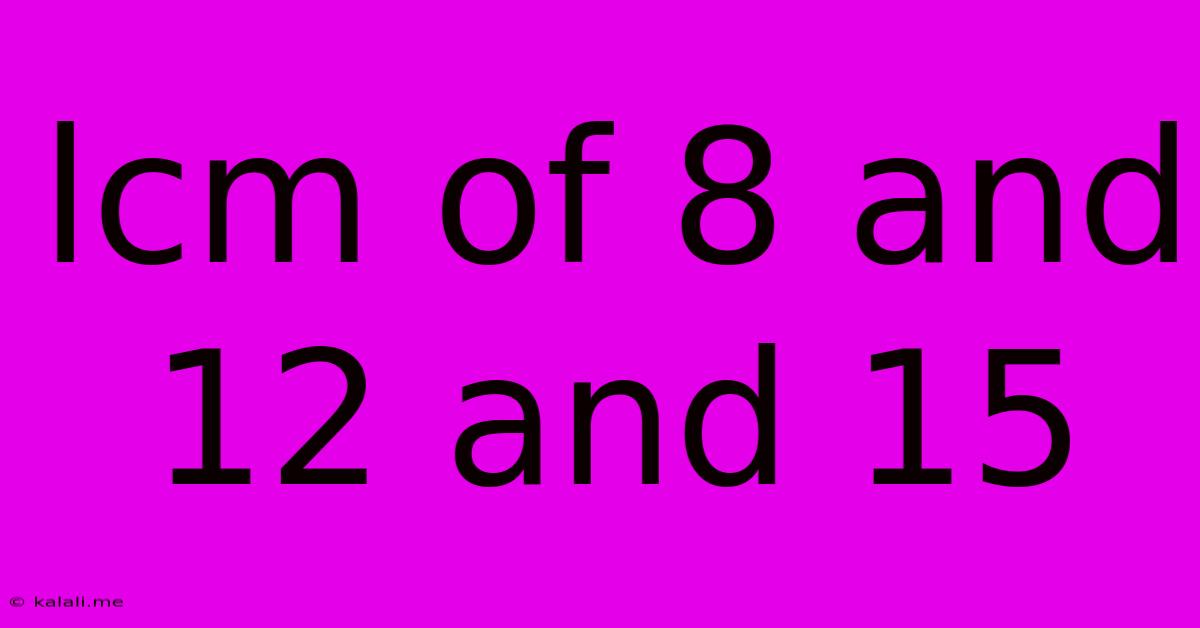Lcm Of 8 And 12 And 15
Kalali
Jun 15, 2025 · 2 min read

Table of Contents
Finding the Least Common Multiple (LCM) of 8, 12, and 15
This article will guide you through the process of calculating the Least Common Multiple (LCM) of 8, 12, and 15. Understanding LCM is crucial in various mathematical applications, from simplifying fractions to solving problems involving cycles and timing. We'll explore different methods to find the LCM, making this concept accessible to everyone.
What is the Least Common Multiple (LCM)?
The least common multiple (LCM) is the smallest positive integer that is divisible by all the numbers in a given set. In simpler terms, it's the smallest number that all the numbers in the set can divide into evenly. This is distinct from the Greatest Common Factor (GCF), which is the largest number that divides evenly into all numbers in a set. Understanding both LCM and GCF is vital for various mathematical operations.
Methods for Finding the LCM of 8, 12, and 15
There are several ways to calculate the LCM, and we'll explore two common approaches:
1. Listing Multiples Method
This method is straightforward, especially for smaller numbers. We list the multiples of each number until we find the smallest multiple common to all three:
- Multiples of 8: 8, 16, 24, 32, 40, 48, 56, 64, 72, 80, 96, 120...
- Multiples of 12: 12, 24, 36, 48, 60, 72, 84, 96, 108, 120...
- Multiples of 15: 15, 30, 45, 60, 75, 90, 105, 120...
By comparing the lists, we see that the smallest common multiple is 120.
2. Prime Factorization Method
This method is more efficient for larger numbers. We find the prime factorization of each number and then build the LCM using the highest power of each prime factor present:
- Prime factorization of 8: 2³
- Prime factorization of 12: 2² × 3
- Prime factorization of 15: 3 × 5
To find the LCM, we take the highest power of each prime factor present in the factorizations:
- Highest power of 2: 2³ = 8
- Highest power of 3: 3¹ = 3
- Highest power of 5: 5¹ = 5
Now, multiply these highest powers together: 8 × 3 × 5 = 120
Therefore, the LCM of 8, 12, and 15 is 120.
Applications of LCM
Understanding LCM has practical applications in various fields:
- Fraction addition and subtraction: Finding a common denominator involves finding the LCM of the denominators.
- Scheduling and timing: Determining when events will coincide, such as the overlapping of bus schedules or repeating tasks.
- Number theory: Solving problems related to divisibility and modular arithmetic.
Conclusion
Finding the LCM of 8, 12, and 15, whether through listing multiples or prime factorization, yields the same result: 120. Choosing the best method depends on the numbers involved; the listing method is simpler for smaller numbers, while prime factorization is more efficient for larger numbers or when dealing with a greater number of integers. Mastering LCM calculation is a fundamental skill with far-reaching applications in mathematics and beyond.
Latest Posts
Latest Posts
-
What Earthquake Waves Cause The Most Damage
Jun 15, 2025
-
The Weight Of An Object Is
Jun 15, 2025
-
Similarities Between A Square And A Rhombus
Jun 15, 2025
-
Moving Decimals To The Left Or Right
Jun 15, 2025
-
A Manometer Is Used To Measure
Jun 15, 2025
Related Post
Thank you for visiting our website which covers about Lcm Of 8 And 12 And 15 . We hope the information provided has been useful to you. Feel free to contact us if you have any questions or need further assistance. See you next time and don't miss to bookmark.